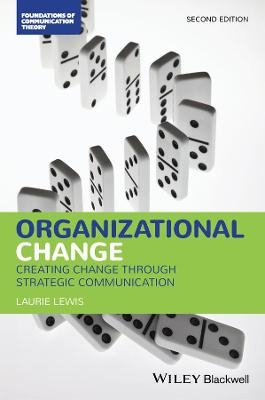
Organizational Change
Wiley-Blackwell (Verlag)
978-1-119-43124-4 (ISBN)
Organizational Change provides an essential overview to implementing deliberate and focused change through effective communication strategies. Author Laurie Lewis integrates academic rigor with real-world case studies to provide a comprehensive examination of both theoretical and pragmatic approaches to alterations and modifications of organizational structures. Emphasizing the importance of formal and informal communication in implementation of change, this text investigates methods of information dissemination and examines various channels for communicating change. Coverage of stakeholder relationships, concepts of uncertainty and resistance, assessing change outcomes, and more provides readers with a solid foundational knowledge of change dynamics in organizations.
Extensively revised and updated, this second edition provides new case studies on topics such as design of input solicitation, and current research in areas including the persuasive effects of sidedness or inoculation, and socially supportive communication. Improved pedagogical tools, streamlined organization of topics, and additional charts, graphs, and images reinforce efficient presentation of material and increase reader retention and comprehension.
Examines empirical, theoretical, and conceptual approaches to strategic communication during organization change
Explores key elements of change, appropriate communication strategies, and outcome evaluation methods
Presents adaptive and programmatic strategic implementation models
Provides studies of real-world companies and actual research on organizational change
Debunks popular myths and clarifies misunderstandings of research and theory on implementation of change
Demonstrates how Individuals, groups, and entire organizations can create change and influence implementation.
Organizational Change provides a thorough survey of the communication and implementation strategies, methods, and conceptual foundations of change in public and private sector organizations, suitable for undergraduate and graduate study and practitioners with interest in complex change implementation.
Dr. Laurie Lewis is a Professor of Communications at Rutgers University and a Fellow at the Rutgers Center for Organizational Leadership. She is co-editor of Volunteering and Communication and the International Encyclopedia of Organizational Communication and has written numerous academic publications on topics related to organizational change, collaboration, inter-organizational communication, and stakeholder communication. Dr. Lewis has provided consulting and training for organizations including nonprofits, civil society organizations, Fortune 500 companies, and higher education institutions.
Introduction 1
State of the Art 3
Weaknesses in Current Approaches to Change Implementation 4
A Stakeholder Theory Perspective 7
Highlight Box 1: Hershey Builds a Community 9
A Communication Perspective 12
Cases of Organizational Change 14
Ingredients Incorporated 14
Spellings Commission on Higher Education 15
Conclusion 18
1 Defining Organizational Change 20
The Role of Communication in Triggering Change 21
Failure in Change 24
What Is Organizational Change? 25
Drive‐thru Diffusion 27
Communication, Social Pressure, and Diffusion 28
Highlight Box 1.1: The Malcolm Baldrige Award 30
Implementation 31
Understanding Key Terms 32
A Complex Model of Innovation, Diffusion, Adoption,and Implementation 34
Case Box 1.1: Ingredients Inc. Experiences Overlapping Changes 37
Types of Organizational Change 37
Complexity of Change Within Organizations 42
Interdependence 42
Structures 44
Politics 46
Case Box 1.2: Spellings Commission Political Positions Play a Role 48
Conclusion 49
2 Processes of Communication During Change 53
Formal Communication 54
Case Box 2.1: Spellings Commission – Responses to Change Announcement 55
Informal Communication 55
Importance of Communication 56
Communication Processes 57
Information Dissemination and Uncertainty 58
Common Practice Advice for Information Dissemination 62
Selecting Channels for Communicating Change 64
Case Box 2.2: Ingredients Inc. – Information Dissemination Campaigns 65
Informal Information Dissemination 66
Case Box 2.3: Spellings Commission – Stakeholders’ Informational Campaign 67
Creating Knowledge 68
Soliciting Input 69
Practice Advice for Seeking Input 70
Voice and Empowerment 70
Design of Input Solicitation 73
Categorizing Approaches to Input Solicitation 76
Perspectives of Input Providers 79
Stakeholders’ Input Solicitation 81
Case Box 2.4: Spellings Stakeholders Solicit Input from Each Other 82
Socialization 83
Case Box 2.5: Homeless Net Resists Altering Role Schema 87
Conclusion 88
3 A Stakeholder Communication Model of Change 94
Stakeholder Theory 95
Highlight Box 3.1: HUD As a Definitive Stakeholder for Agencies Serving Homeless Populations 99
Case Box 3.1: Homeless Net Implementation of Listserv Increases Awareness of Stakeholders 100
Complicating Stakeholder Relationships 102
Multiple Stakeholder Identities 104
Highlight Box 3.2: IT Reskilling Case Study – How Stakeholder Groups View Change Differently 107
Stakeholder Interactions 108
Highlight Box 3.3: Upton Sinclair Sets off Stakeholder Advocacy to Clean up Meat Packing Factories 109
Roles Stakeholders Play in Change 110
Opinion Leaders 110
Connectors 111
Counselors 112
Journalists 114
Highlight Box 3.4: Examples of “Alt” US Government 115
Stakeholder Model of Implementation of Change 115
Outcomes 116
Stakeholders’ Concerns, Assessments, and Interactions 117
Communication Strategies 117
Antecedents 119
Model Overview 119
Conclusion 120
4 Outcomes of Change Processes 126
The Importance of Goals 127
Assessing Change Outcomes 128
Timing of Assessing Outcomes 129
Assessing Outcomes from Multiple Perspectives 129
Difficulty of Metrics of Success 131
Case Box 4.1: Homeless Net Struggles to Assess a Large Mission 132
Attribution Errors 133
Documenting Failure 135
Highlight Box 4.1: March of Dimes Succeeds to the Brink of Organizational Death 136
Assessing Change Outcomes 137
Fidelity and Uniformity 138
Organizational Goals 141
Authenticity 141
Assessing Results of Change 143
Case Box 4.2: Ingredients Inc. – Foreknowledge and Change Burnout 145
Causes for Implementation Failures and Successes 146
Conclusion 150
5 Communication Approaches and Strategies 156
Uniformity, Fidelity, and Models of Implementation 159
Communication Strategy Dimensions 162
Dissemination/Soliciting Input 162
Highlight Box 5.1: Gap’s Campaign for Cultural Transformation 163
Highlight Box 5.2: CEO of Lego Transforms Co.Through Widespread Empowerment Strategy 165
Case Box 5.1: Spellings Stakeholders Solicit Input and Disseminate Information 167
Sidedness 168
Case Box 5.2: One‐ and Two‐Sided Messages from Spellings Stakeholders 171
Reluctance to Acknowledge Negatives 172
Highlight Box 5.3: Companies Use Euphemisms to Avoid Saying “Layoffs” 173
Gain or Loss Frame 175
Targeted or Blanket Messages 177
Case Box 5.3: Memo to Ingredients Inc. 178
Case Box 5.4: Official Statement by the Department of Education on Spellings Commission Report 179
Discrepancy and Efficacy 181
Channels for Communicating 183
Conclusion 185
6 Power and Resistance 191
Power During Organizational Change 192
Case Box 6.1: Spellings Commission’s Latent Power Recognized 195
Bases of Power 196
Case Box 6.2: Homeless Net Recognizes Expertise Power of Implementers 197
Meaning‐Centered Approach to Power 198
Balances of Power 199
Highlight Box 6.1: JAR Technologies Experiences Concertive Control 202
Resistance During Change 202
Thinking Patterns that Explain Managers’ “Resistance” Focus 203
Highlight Box 6.2: Defensive Routines in Implementing Strategy 205
What Is Resistance? 205
Forms of Resistance 208
Highlight Box 6.3: Mice Don’t Overanalyze Change 210
Dispositional Resistance 216
Value of Resistance 218
The Facebook Example 219
Highlight Box 6.4: Moving Cheese Might Require Thoughtful Consideration 221
Conclusion 221
7 Antecedents to Strategies, Assessments,and Interactions 227
Institutional Factors 229
Implementers’ Perceptions of Change Context 232
Assessing Stakeholders and Stakeholder Values 232
Case Box 7.1: Reactions of Powerful Stakeholders 235
Assessing Needs for Consensus‐Building 236
Assessing Needs for Efficiency 237
Assessing Individual and Organizational Change History and Readiness 238
Case Box 7.2: History as Prologue? Spellings Report Triggers Comparisons to NCLB 239
Assessing Goals for Change 240
Case Box 7.3: Flip‐Flopping on Anticipation of Change 241
Stakeholders’ Perceptions of Change Context 242
Case Box 7.4: Discrepancy Messages Overplayed 244
Case Box 7.5: Supporting Stakeholders through Change 246
Conclusion 248
8 Stakeholder Interactions: Storying and Framing 253
Creating Stories and Storylines That Make Sense 255
Highlight Box 8.1: How We Make Stories 255
Case Box 8.1: Threads of Merger Stories 257
Highlight Box 8.2: Story of Bad Treatment 258
Making Stories 258
Case Box 8.2: Varying Stories About What Was Announced as Change 259
Framing 260
Frames Tell Stories from a Perspective 260
Interactional Frames 261
Contesting and Resisting Stories and Frames 262
Highlight Box 8.3: Attempts at Framing 263
“Managing Meaning” 264
How Non‐Managerial Stakeholders “Manage Meaning” 265
Stories and Frames Create, Maintain, and Resolve Concerns 265
Concerns about Process or Substance of Change 268
Creating and Resolving Alliances, Rivalries, and Schisms 270
Highlight Box 8.4: Terse Telling 271
Highlight Box 8.5: “We Don’t Want It Either” 272
Highlight Box 8.6: Reframing and Resistance 273
Which Stories and Frames Matter? 274
Highlight Box 8.7: Social Sensemaking Sets Up Material Disappointment 276
Conclusion 277
9 Applying the Model in Practice 281
Activity Tracks 282
Managing Meaning 283
Managing Networks 283
Managing Practice 284
Keeping Track of the “Tracks” 284
Stakeholders Must Manage Activity Tracks 285
Preview of Chapter and Case Introduction 286
Tools for Managing Activity Tracks 286
Monitoring and Articulating Goals 286
Highlight Box 9.1: Virtual Problems 287
Developing Strategic Messages and Strategic Communication Plan 291
Analysis of Input 294
Influencing Implementation Climate 297
Myths about Implementing Planned Change 299
Conclusion 302
Glossary 304
Index 315
| Erscheinungsdatum | 04.01.2019 |
|---|---|
| Reihe/Serie | Foundations of Communication Theory Series |
| Verlagsort | Hoboken |
| Sprache | englisch |
| Maße | 152 x 226 mm |
| Gewicht | 522 g |
| Themenwelt | Sozialwissenschaften ► Kommunikation / Medien ► Kommunikationswissenschaft |
| Wirtschaft ► Betriebswirtschaft / Management ► Planung / Organisation | |
| ISBN-10 | 1-119-43124-7 / 1119431247 |
| ISBN-13 | 978-1-119-43124-4 / 9781119431244 |
| Zustand | Neuware |
| Informationen gemäß Produktsicherheitsverordnung (GPSR) | |
| Haben Sie eine Frage zum Produkt? |
aus dem Bereich


